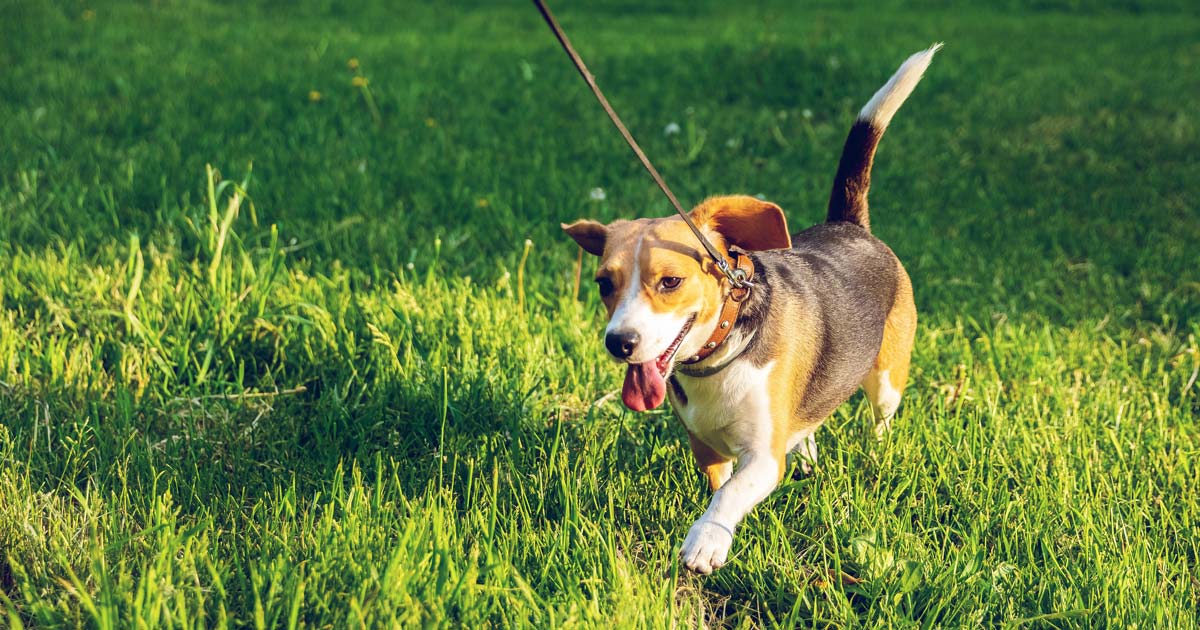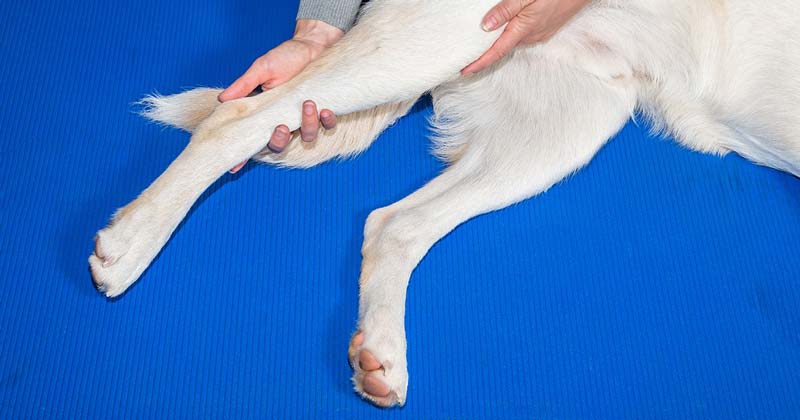15 Nov 2019
General OA and joint pain: updates, actions and guiding clients

Figure 1. Low impact, short, regular training sessions lead walking on soft terrain is the most beneficial to OA dogs.
OA is the most common form of degenerative joint disease (DJD; Bland, 2015), with an estimated 20% of adult canines affected (Hou, 2016) and 90% of cats older than 12 years of age having radiographic evidence of DJD (Hardie, 1997).
OA is a chronic progressive disease characterised by pathological changes of the moveable joints (Fritsch et al, 2010). OA results in loss of cartilage and the formation of spurs of bone around the joint, and is associated with pain, stiffness and reduced activity levels. Pathology includes changes in the articular cartilage, subchondral bone and joint capsule (Skeldon, 2014).
OA in dogs usually has a specific underlying cause and is, therefore, often seen earlier in life. Underlying causes can include developmental conditions such as elbow or hip dysplasia, ligament rupture and trauma, such as broken bones involving a joint – for example, humeral condylar fractures. Cats are more commonly affected by “wear and tear” like humans and consequently tend to be affected later in life.
The clinical signs of OA include stiffness, lameness and pain. Stiffness and lameness is often evident after a period of rest in dogs – especially after previous exercise. Joint pain associated with OA can manifest in a number of ways – including reluctance to climb, jump or exercise, restless sleep and altered behaviour, including changes to grooming and aggression. Clinical signs of OA in cats are often less obvious than in dogs.
Joint anatomy
A joint is where two bones meet, and the most common are synovial, which allows movement (diarthrosis) between two bones. The feature that facilitates this movement makes it susceptible to inflammation and damage. Around the ends of the bones is a joint capsule filled with synovial fluid, which lubricates the joint and reduces friction between the bones.
Synovial joints are characterised by the presence of:
- synovial membrane
- fibrous joint capsule
- articular surfaces
- synovial fluid
- ligaments
- meniscus/menisci
They can be further classified according to the range of movement they allow. The joint is supported by external structures, including ligaments (attaching bone to bone), tendons (attaching muscle to bone) and bursae (pockets of synovial fluid). All of these facilitate movement. In OA, inflammation causes secondary changes in the joint and external supporting structures.
What can be done?
Following an OA diagnosis by a vet, treatment should aim to improve the quality of life through symptomatic and supportive measures. Environmental and management strategies should be devised according to a patient’s individual needs to ensure a holistic approach. Options may include surgery for cruciate ligament rupture or special diet plans for obese patients (Piermattei et al, 2006).
VNs can play a vital role in delivering specialist nursing care through puppy/kitten, weight, senior and OA clinics, in-patient care, and assisting with treatment and rehabilitation therapy. Owner compliance is vital to the successful management of OA, and nurse-led clinics in particular are an invaluable tool for educating and supporting owners, and monitoring a patient’s response to treatment.
The VN can ensure treatment options and lifestyle changes are discussed, as well as make sure an individual’s progress and response to treatment is monitored at regular intervals.
Management strategies
General management strategies for OA are:
- pain management
- exercise modification
- nutritional and weight management
- nutraceuticals
- adjunctive therapies
- surgery
Pain management and monitoring
Effective analgesia is the goal of conservative management of patients with OA and this will be achieved under the direction of the veterinary surgeon. However, VNs can play a huge role in OA and pain management clinics to support both the client and patient.
NSAIDs are often prescribed to manage the clinical signs of OA because of their ability to reduce joint pain and inflammation. It is important for the VN to have a good knowledge and understanding of the drug therapy options to educate owners appropriately once a vet has prescribed medication(s).
The assessment of chronic pain in a brief follow-up consultation can be misleading and other methods should be considered, including the use of owner questionnaires, which can be used for long-term monitoring (Brown et al, 2008).
In the human field, the standard methods for assessing chronic pain are validated, patient-completed, clinical metrology instruments (CMIs; Altman et al, 1996). A CMI is a sequence of questions that is scored based on the observations or experiences of the person completing it. These individual item scores are then used to calculate an overall instrument score. Several CMIs have been validated in dogs and others are under development in cats.
A team at the University of Liverpool devised a client questionnaire called Liverpool Osteoarthritis in Dogs (LOAD; Walton et al, 2013). LOAD is a validated owner-completed clinical metrology instrument that can be recommended for the measurement of canine OA. This questionnaire is a record of behaviour history, together with clinical assessment, which can provide a more detailed understanding of how the disease is progressing – and, importantly, how healthy and comfortable the patient is.
The study by Walton et al (2013) concluded the most reliable data on this disease is often gathered from informally asking owners for their observations of their pet’s behaviour.
A Feline Musculoskeletal Pain Index has also been developed. It measures the impact of OA on pain (adverse sensory and emotional experience), mobility (quality of moving freely), activity (ability to perform specific activities), and affective effects (mood, as perceived by those caring for the cat; Gruen et al, 2015).
Exercise modification
The benefits of exercising dogs must be stressed to owners. The correct level of exercise will vary from dog to dog, but it is reasonable to provide regular exercise to the highest level possible that does not induce prolonged exacerbation of clinical signs. Low-impact, short, regular sessions lead walking on soft terrain is the most beneficial. Off-lead, sudden, stop-start, chasing exercises will lead to increased shear action on joints and stress to the extremities of the ranges of motion (Figure 1; Hutchinson, 2018).

Hill walking can also be useful by altering the usual weight loading on joints. Owners will need to understand that exercise needs will vary according to the clinical stage of the disease. Small changes to a cat’s environment can make a significant difference to the pain and discomfort. When considering exercise modifications for cats, the use of steps, ramps, raised feeding bowls and low-level litter trays may improve quality of life.
Nutritional and weight management
Excess weight increases the load on damaged joints and, along with the shearing forces associating with inappropriate exercise, it can be hugely detrimental. Weight loss should be presented as an important treatment modality to owners – particularly in obese dogs with OA.
A study by Marshall et al (2010) found that a noticeable improvement may be seen after modest weight loss in the region of 6.10% to 8.85% bodyweight. Successful weight loss programmes rely on the correct choice of diet, accurate administration and strict adherence by the owner.
It is also likely most OA patients will have undergone a degree of muscle atrophy due to pain and inactivity, and will lack muscle support (Hutchinson, 2018). Therefore, appropriate exercise, nutrition and physiotherapy is required to start addressing requirements for weight control and body condition. Consideration should also be made to underweight patients. Senior patients can lose body condition and become very thin, with reduced muscle mass and strength. This can lead to reduced activity levels and, eventually, reduced joint mobility.
Preventive measures should be taken to help fast-growing puppies – especially large breeds that are at risk of developmental disorders, such as hip dysplasia, elbow dysplasia and osteochondrosis. This can be achieved by a balanced commercial diet, and by avoiding excess nutrition and rapid development.
The major pet food manufacturers also make specific diets aimed at helping to improve mobility. These generally combine a high-quality diet with added nutraceuticals, such as chondroitin, glucosamine, omega-3 oils and essential fatty acids. It can be an effective way for owners to provide joint supplementation. Diets rich in omega-3 fatty acids – in particular, eicosapentaenoic acid – have been shown to reduce the degradative enzymes that cause cartilage damage (Toll, 2005). Evidence exists that therapeutic diets can reduce the dose of carprofen and meloxicam without compromising efficacy (Fritsch, 2010).
Nutraceuticals
Nutraceuticals are commonly used for the management of OA-associated pain and include products such as glucosamine, chondroitin sulphate, green-lipped mussel powder and dietary supplementation with omega-3 fatty acids. Most have demonstrated anticatabolic and anti-inflammatory effects, but little data exists regarding the pharmacokinetics (Comblain et al, 2016).
The results of 17 trials evaluating the impact of nutraceuticals on OA in dogs and cats were reviewed (Vandeweerd et al, 2012), and the authors concluded the strength of evidence was low for all nutraceuticals, with the notable exception of diets supplemented with omega-3 fatty acids, including green-lipped mussels, in dogs.
Adjunctive treatment
Physiotherapy; hydrotherapy; acupuncture; massage; and newer techniques, such as laser and shockwave therapy, can be introduced as adjuncts in OA management (Figure 2).

What’s new?
Research is progressing in the field of cellular therapy as an option for dogs with OA, and current evidence supports their use in patients that have failed to respond adequately to more conventional therapies. These therapies include mesenchymal stem cells (MSCs) and autologous platelet therapy (Perry, 2016).
Stem cells are undifferentiated cells with the ability to divide indefinitely without losing their properties and eventually produce specialised cells (Diekman and Guilak, 2013). MSCs are multi-potent, which means they can differentiate into a number of cell types, such as chondrocytes, osteoblasts or fibroblasts. Adult stem cells can be harvested, either from the patient’s fat or bone marrow, multiplied in a lab and then re-implanted. Studies in human patients have been shown to improve clinical signs and although they do not stop the progression of OA, they may modulate the degenerative and inflammatory processes.
The most recent clinical evidence reported that MSCs can not only reduce pain and inflammation, but also improve quality of life and enhance tissue repair (Shah et al, 2018). The WSAVA recognises stem cells in their pain management protocol, and include stem cell injections for DJD in dogs and cats in their Pain Council Guidelines.
Another advanced technique is plasma platelet rich plasma therapy. This is defined as an autologous superconcentrate of platelets, which are used to accelerate healing in injured live tissues. The process involves taking a large blood sample to extract a concentrated dose of the body’s anti-inflammatory mediators, which is then injected directly into osteoarthritic joints. Growth factors present in platelets can reportedly enhance the regenerative processes in OA joints (Textor, 2011).
Summary
OA is a progressive condition, so clients should be educated that the disease can be managed, but not cured. However, it can be managed effectively with a multimodal approach using diet, nutraceuticals, weight loss/control, exercise modification and drug therapy.
VNs can work in symbiosis with the veterinary surgeon and owner to create an appropriate management strategy. Regular patient monitoring is essential to achieve a successful treatment programme to suit the patient, making the VN’s knowledge and support an integral aspect of successful management of OA.
